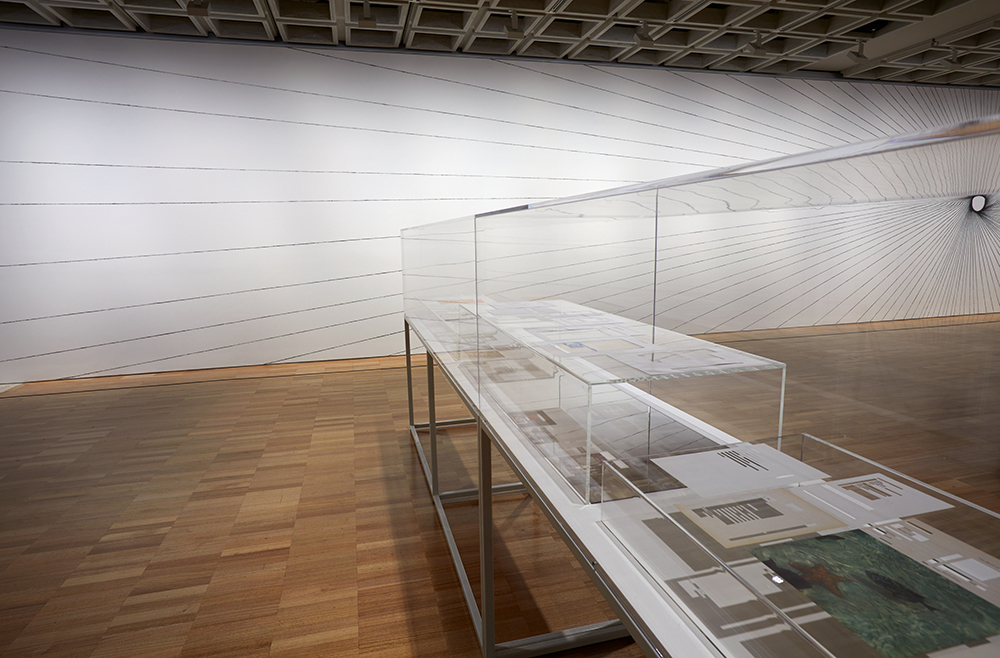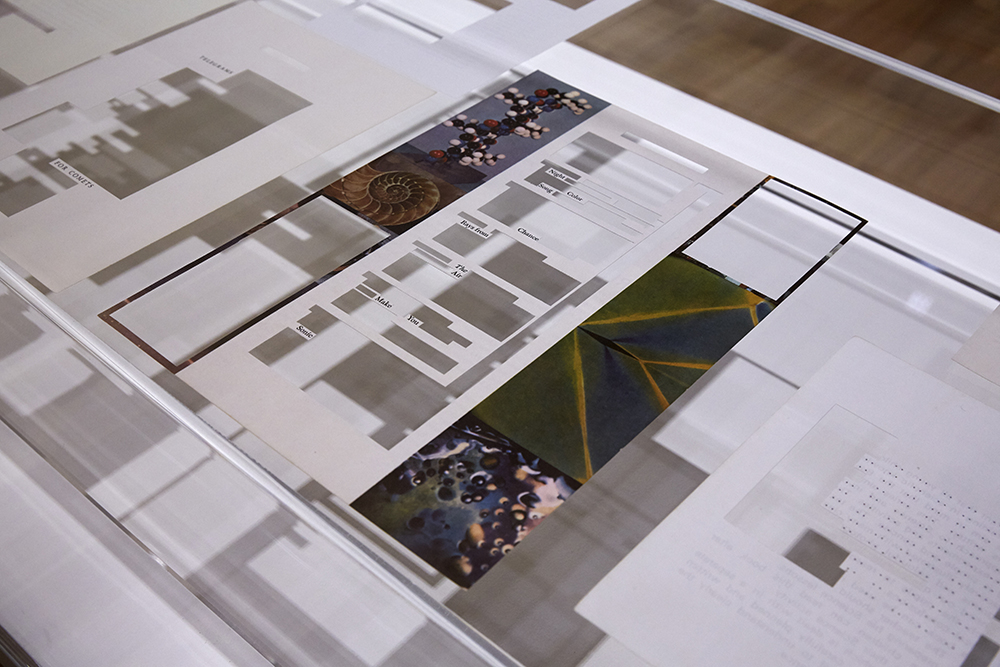A sonic boom, then silence:

12 July, 2019
This is the final instalment in Running Dog’s feature series responding to individual works in The National 2019: New Australian Art—on view at the Art Gallery of New South Wales, Carriageworks and the Museum of Contemporary Art, and curated by Isobel Parker Philip (AGNSW), Daniel Mudie Cunningham (Carriageworks), Clothilde Bullen and Anna Davis (MCA).
An arrangement of pages encased in glass.
Poem, aphorism, riddle.
Distending the space between words; the gape of perforations.
Deliberate redactions: an excision, not an erasure.
The silences are sculptural.
‘I
Live’
The rungs between the words like the passing of decades.

Sandra Selig, Content in a Void (detail) (2018)
altered contents pages from used books, mirrors dimensions variable
This project has been supported by Atelier, Art Gallery of New South Wales
Courtesy the artist, Milani Gallery, Brisbane and Sarah Cottier Gallery, Sydney © the artist
Image credit: AGNSW, Diana Panuccio
Precise outlines and neat corners silhouette a brutalist architecture.
A small square stacked atop a line, over and again in stepping stones; slim columns that hem in the margin of a page; nesting stacks of tetris blocks; entire paragraphs cut from the page; a laddering of notched slits.
The neatness of the wound (ablation) claims a false order. The selection of words plucked from the swamp of textual matter, and those discarded by way of a cold unlit hole, the phrasing that results: it’s all arbitrary.
The harmonious, hypnotic lilt of them (‘Wayward Hammer of Infinity’) offers no more truth than a fortune cookie.
The beauty, though, lies in the pretence (pretending at insight), in the affectation of truth (‘I hid in matter’). A consolation. Content as a consolation in/from the void.
In this arrangement, the artist performs not the act of the writer, of inscribing or imposing one’s own sensibility.1
The artist is playing god: reordering pre-existing matter of the universe, pulling out certain textual molecules, while consigning others to silence. Creating meaning out of chaos.
Here is language’s cardinal function: as a technology of comprehension, of world making.

Sandra Selig, Content in a Void (detail) (2018)
altered contents pages from used books, mirrors dimensions variable
This project has been supported by Atelier, Art Gallery of New South Wales
Courtesy the artist, Milani Gallery, Brisbane and Sarah Cottier Gallery, Sydney © the artist
Image credit: AGNSW, Diana Panuccio
I have read of leaving gaps in writing as a chink to let the light rush in (god; or, the reader).2
Where absence is a cipher for desire.3 It demands attraction: the imagining mind working to fill in or interpret; grasping at; expanding into. ‘Making use of the void to think the full.’4
A black hole is not an absence, but an excess of matter. Points in space so dense that they create sinkholes of gravity. The words that once structured each page have been dragged over the edge.
A sucking blackness.
Their meaning elided into the homogeneity of the void.
A sonic boom, and then silence.
Slip over the sheer, slick, cliff face of these cornered slashes, and be shunted through layers of geological time: the ribbed whorl of an ammonite fossil; red and white baubled strands of DNA; the marbled blue of light refracting through shallow ocean water. Photographs collected from found books, a few decades old, cast in warm tones and soft at the edges. A matte finish. Gathered together in a time-lapse, a shorthand for some billions of years of evolution.
These are interruptions with hard walled edges. Self-contained absences that swell into presence as they expand to absorb our attention; ‘a hollow in relation to a relief.’5 The few remaining words, now stranded on geometric islands of white parchment, exert their prominence.
Obliquely courting the unsaid.
DEATH MEASURES LIFE
Moon Loop for lips
Ancient Puzzle of the Future
7 BILLION DREAMS A DAY
Chance Rays from The Air Make You Sonic
An allegory for the metaphysical.
Others work as ideogram:
MOON
oo
oo
oo
oo
oo
oo
Occulations oo
The shape of the ‘oo’ performing meaning as much as what is meant by the word (an egg and its innards). Actors of equal size, or blinking eyes, poised. Ready to slip in front of the other and occlude, or eclipse.

Sandra Selig, Content in a Void (detail) (2018)
altered contents pages from used books, mirrors dimensions variable
This project has been supported by Atelier, Art Gallery of New South Wales
Courtesy the artist, Milani Gallery, Brisbane and Sarah Cottier Gallery, Sydney © the artist
Image credit: AGNSW, Diana Panuccio
How many breaths to measure the distance (a temporal caesura) between ‘TELEGRAMS’ and ‘FOR COMETS’ (a single deep inhale?); or, ‘COLD’, ‘SLOW’, ‘BOOM’, where it is not a single ribbed strip, but several stacked in a row that lance the page to cleave apart words?
These perforations (step on a crack, you’ll break your back; step on a line, you’ll break your spine), the fissures that run through each page, are contra-rhythmic. They rupture the natural pace of syllables, of phrase. So partitioned, words drop in isolation into the pool of consciousness. Fractured.
MAROONED
on a
BEAUTIFUL
VOICE
A stutter, then a flatline.
Syntactic scissoring is the term used to describe ruptures in a text that break against rather than with a phrase.6
‘A gap in the universe: nothing that was visible, nothing invisible.’7
- Joan Didion, ‘Why I write’, New York Times Book Review, (05/12/76)
- Maggie Nelson, The Argonauts, (Minneapolis: Minnesota Graywolf Press, 2015), p. 61
- Erin Wunker, ‘Border of Becoming: An Examination into Absence and Desire for Self and Subjectivity in Anne Carson’s Men in the Off Hours and Gail Scott’s Main Brides’ (Montreal: McGill University, 2004)
- ibid, p. 50
- Blanchot, p. 422
- Charles Bernstein (ed.), Close Listening: Poetry and the Performed Word, (Oxford: Oxford University Press, 1998), p. 153
- Blanchot, p. 422